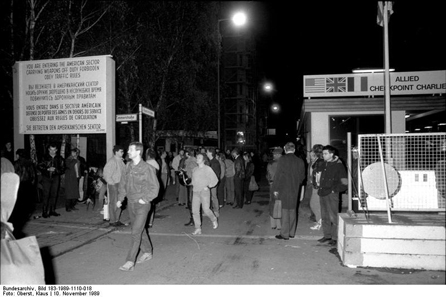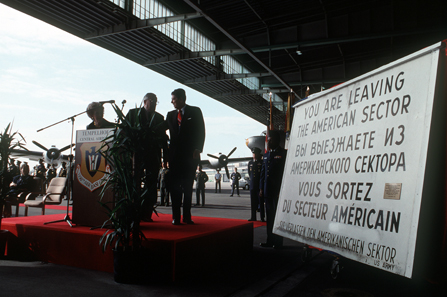by Ursula Kampmann
October 17, 2013 – Alan Wolan is one of these ingenious business men who take advantage out of everything. When he heard about the Berlin wall being fallen he decided to go to Berlin to sell reunification souvenirs to thousands of tourists he expected for the next year. And Wolan was absolutely right. He made a small fortune with his souvenir shop. At the epoch his booth was located corner Friedrich- and Kochstraße right beside the famous Checkpoint Charlie …
Checkpoint Charlie in the night of November 10, 1989. For the very first time for decades it was possible to pass without being controlled. Photograph: Bundesarchiv, Bild 183-1989-1110-018/Oberst, Klaus/CC-BY-SA.
This place steeped in history was dismantled on June 22, 1990. At this epoch it was zeitgeist to do so. Full of joy over being reunited the Germans removed all testimonies of the former separation as if this separation had never existed. The so-called wallpeckers hacked the wall into minute pieces. The historical control barrack of Checkpoint Charlie was removed by a crane while the four foreign ministers of the allies watched attentively. What remained was the sign that for decades had announced that you were leaving the American sector …
The ambassador of the USA presents the now superfluous sign of Checkpoint Charlie to President Ronald Reagan during his Berlin visit on September 14, 1990. Photograph: TSGT Fernando Serna / US Air Force. / Wikipedia.
But was it really the ‘original’ sign? Looking at photographs of this landmark made in different years one quickly notices that the signs were exchanged over the years when they had been afflicted so heavily by the weather that they were no longer of any use. You can recognise this by the small numbers in the right lower corner besides the legend ‘U.S. Army.’ The US Army has had similar signs in stock with no doubt. Otherwise we could not explain what happened after September 22.
The preparations of the ceremonial removing of Checkpoint Charlie in the presence of the ministers proceeded rather hastily. After the ceremony the sign was forgotten or his removal postponed to the following day. Probably nobody expected that the heavy sign which two powerfully built men could lift only with much difficulties would simply disappear.
But what people did not consider was Alan Wolan’s criminal energy. In an interview with German newspaper ‘Süddeutsche Zeitung’ published in the ‘SZ Magazin’ no. 37 of September 13, 2013, he described the theft as follows: ‘Cutting it away took about fifteen minutes. Everything went smoothly – except that suddenly we saw two young soldiers of the German Democratic Republic coming towards us right from the eastern part of the border post.’ They hid their tools and behaved like a group of American tourists until the soldiers had passed off. Only in a second step Wolan and his three accomplices loaded the sign into a van and drove away.
In 1990 no scandal was made about it. On the contrary, right the following day another sign was mounted. After all, that stuff was in stock and the persons in charge were embarrassed themselves over the theft. So, why not cover it up? And so it happened that during his visit on September 14, 1990 Ronald Reagan was presented a Checkpoint Charlie sign that probably had witnessed the reunification in the depot.
Nobody has missed so far this small piece of Germany’s post-war history. This is allegedly why Alan Wolan has been looking for publicity now. In the end he tries to make as much money as possible with the stolen goods. Criminal prosecution he does not fear. According to German law petit larceny prescribes after five years.
Now Alan Wolan is searching to prove that his sign is the ‘original.’ This fact is disputed vigorously at least by the director of the privately owned museum ‘House at Checkpoint Charlie.’ That, in turn, is no wonder since the private museum would be left with one attraction less if the original sign were no longer the original sign.
Wolan’s story sounds plausible, though, and is now commonly accepted. Currently Berlin’s newspapers are discussing assiduously whether Berlin cash-strapped as usually should fulfil the thieve’s demand which in the meantime has been raised to one million euros. Even mayor Wowereit gave a statement on that behalf saying ‘We have no money for such absurd demands.’
Actually everything seems to be so simple, though: Germany has cultural property laws anyhow. And the sign that saw the reunification at Checkpoint Charlie is arguably the best example of a ‘national property of artistic, historical or archaeological value.’ So it is high time that the German government asks the USA to restitute this national symbol. It seems to be certain that this sign is cultural property and that this cultural property has been stolen, at least, if it is really the original sign.
But maybe something completely different stands behind all that. Alan Wolan is head of a PR agency. In a Youtube video he explains the chances of small enterprises to make a name for themselves. He bets on advertising in places where nobody would expect it to be done. Well, if we wait another couple of months maybe the whole story reveals itself as a smart publicity gimmick for his PR agency.
English-speaking media, so far, have not yet reported on this case. Only ‘The Local’ gives a short notice.
Here you can find the original article from the Süddeutsche Zeitung.
Here Alan Wolan speaks about commercials. Until October 16, 2013 only 1,380 visitors had watched his video. Maybe in the next couple of weeks this will change significantly …






